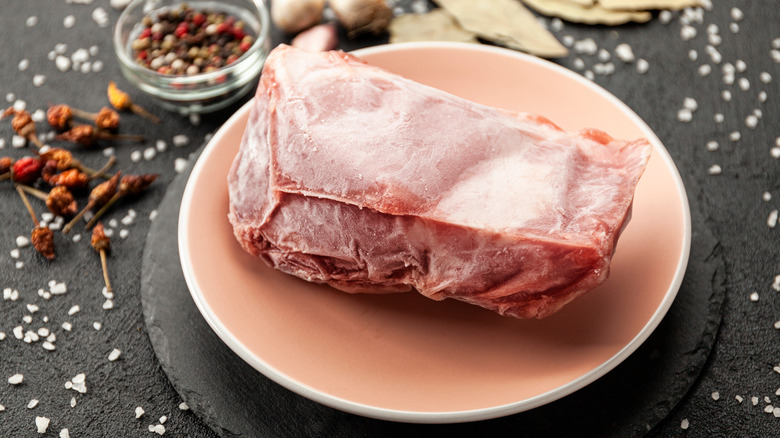The Defrosting Mistake Gordon Ramsay Says Will Make Steak Chewy
Let's face it, the way you defrost steak matters. When done correctly, you end up with a tender, buttery steak that requires little effort with a knife. When thawed incorrectly, well, let's just say no one likes a rubbery steak.
While there are several methods for defrosting steak, some are much better at helping you achieve the desired end results you're looking for (aka a perfectly cooked steak) than others. The safest way, according to MasterClass, is to place the frozen steak in the refrigerator and allow the temperature of the meat to slowly increase ... but unfortunately for all you last-minute planners out there, this can easily take over a day. Another way requires submerging the food in cold water to slowly change its temperature or defrosting in the microwave.
Which defrosting method you choose will likely depend on the amount of time you have and a few other factors, but you'll want to know they are not all created equal and one is particularly unfavorable for steak, according to Gordon Ramsay.
The steak defrosting method to avoid
Even if defrosting steak in the microwave is the quickest method, Ramsay tells MasterClass it's best to avoid it altogether unless you have no other option. He says the microwave method works well for food like veggies and pasta sauces, but meat, not so much, as it can wreak havoc on a beautiful piece of beef, causing discoloration and a rubbery texture.
And beyond potentially ruining your steak, defrosting in the microwave is pretty easy to mess up, which can lead to things worse than a disappointing meal. The Kitchn says that meat thawed in the microwave can turn questionable quickly, due to its ability to rapidly enter the "danger zone," which is what the USDA refers to temperatures between 40 and 140 degrees Fahrenheit as. Dangerous bacteria thrive in this range, which can cause food poisoning. If you absolutely must defrost steak in the microwave, the Kitchn says to cook it as soon as possible.
Give you steak a cold water bath, says Ramsay
For MasterClass, "Hell's Kitchen" star Gordon Ramsay recommends a cold water bath as his preferred method for thawing steak, as ribeye and other cuts of steak can take days to thaw in the fridge, depending on their size. With this defrosting method, you can expedite thawing while still putting saftey first.
You'll want to place the steak in a resealable or vacuum-sealed plastic bag, which Grilling Dad says will help prevent any cross-contamination. Avoid hot water, as this can cause dangerous bacterial growth while your steak is brought up to the correct temperature, and use a spoon or other utensil to help hold the meat down. After being fully submerged for 30 minutes, you can begin checking to see if it is thawed, swapping the water out for new, per the U.S. Food Safety and Inspection Service.
Ramsay says you'll know when the steak is ready to be cooked when it feels soft and fleshy. Any signs of ice or hardness mean that it must continue soaking for longer, but in general, the cold water method takes around 45 minutes per pound of beef.
The science behind the best method
So we have advice straight from the mouth of Gordon Ramsay. But obviously there's a reason to follow this advice other than the fact that Ramsay says so – because as much as his television persona may protest, Ramsay is not God.
The reason a microwave will produce an unpleasant steak is twofold. The first, as The Naked Scientists explain, is that ice does not absorb microwaves as well as water. This is because the chemical compound of ice is locked more rigidly into place. So, when some of the ice does melt, the melted water will continue to absorb the microwaves instead of the remaining ice. The second issue brought up by Cook's Illustrated is that the penetration of a microwave only reaches between a quarter of an inch to an inch. A thick slab of meat, then, won't be radiated all the way to its center. In short, a microwave is simply not the right tool for the job.
ScienceNordic offers a simple explanation for why the water method of defrosting works: "Water conducts heat better than air." But the water shouldn't be warm as that could promote the growth of bacteria. Yes, you could let the meat thaw in the refrigerator, but large ice crystals form when food remains just under the freezing point for too long. If you follow Ramsay's advice, however, you will bypass that problem.



